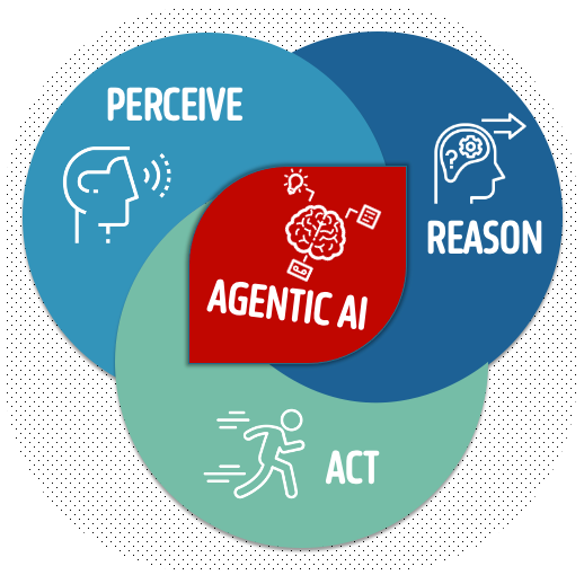
As government IT systems grow increasingly complex, governmental agencies need more adaptive, intelligent solutions. Agentic AI is a breakthrough technology that brings true autonomy to artificial intelligence. Unlike conventional AI, which follows fixed algorithms and predefined tasks within static parameters, agentic AI senses its environment, learns from real-time data, and makes independent decisions that align with strategic goals. This capability transforms how systems operate, enabling new levels of efficiency and adaptability across key IT areas such as operations and maintenance (O&M), security, software development, project management, and help desk management.

At its core, agentic AI, as an autonomous agent, doesn’t have a physical form like a robot or a machine. Instead, it exists as software — a collection of algorithms, models, and decision-making frameworks running on a system or distributed across multiple systems. Think of it as a highly intelligent and adaptive software layer embedded within the digital infrastructure, constantly processing data, making decisions, and interacting with other software and systems in real-time. To understand how agentic AI operates, we break down its capabilities into three core functions: perceive, reason and act. These functions work together to enable the AI to autonomously gather data, analyze it and take informed actions.
Perceive
Agentic AI continuously analyzes structured and unstructured data from various channels, integrating sensor data, API inputs, and machine learning models to form a complete understanding of its environment. It uses natural language processing to interpret commands, image recognition to monitor physical spaces, and data pipelines to aggregate system logs and metrics. By leveraging edge computing, it processes data locally for faster, real-time decision-making in critical contexts like defense.
Reason
After collecting data, agentic AI uses advanced frameworks like reinforcement learning (RL), which allows it to adapt through trial and error, and probabilistic graphical models (PGMs) to reason under uncertainty. It also employs deep neural networks for complex tasks like predicting system failures, helping it identify patterns and make informed decisions.
Act
Once it determines a course of action, agentic AI autonomously executes it using decision engines that trigger actions like rerouting traffic or adjusting resources. It also employs automation frameworks like robotic process automation for routine tasks and continuously refines its behavior through feedback loops, ensuring ongoing optimization.
Agentic AI — O&M
Agentic AI transforms O&M by enabling systems to operate autonomously, continuously monitoring and optimizing performance. Instead of relying on scheduled maintenance or reactive fixes, agentic AI can predict and prevent issues before they disrupt operations, ensuring minimal downtime and cost efficiency. Here’s how it works in practical government settings:
Predictive Maintenance
Agentic AI analyzes real-time sensor data from critical assets — such as servers, HVAC systems, transportation infrastructure, or energy grids — to detect early signs of wear or failure. It predicts when specific components are likely to break down and schedules maintenance before disruptions occur. For example, in government-run power grids or transportation systems, agentic AI automatically dispatches teams to repair equipment before service interruptions happen.
Optimized Resource Allocation
By constantly assessing system health, agentic AI prioritizes maintenance efforts and directly deploys personnel and resources to where they are most needed, reducing delays and operational costs. In government facilities or defense operations, this improves uptime and operational readiness.
Automated Diagnostics and Repairs
Agentic AI autonomously diagnoses system issues, triggers repairs, and reroutes workloads when problems arise. In data centers, it automatically switches to backup systems or reroutes network traffic, preventing outages and maintaining critical operations.
Agentic AI represents a groundbreaking shift in how government IT systems operate, offering autonomy, intelligence, and adaptability far beyond conventional AI. By integrating agentic AI into O&M, security, software development, and project management, agencies can streamline operations, enhance decision-making, and respond dynamically to evolving challenges. As a result, government systems become more efficient, cost-effective, and resilient, positioning agencies to better serve citizens in an increasingly complex technological landscape.
Kartik Mecheri is the Chief Architect at Karsun Solutions. A dynamic leader with a rich background in technology and management, Kartik has spearheaded large-scale digital transformation projects while keeping Karsun’s customers at the forefront of technological advancements. His expertise in cloud computing, modern software development, and enterprise modernization ensure Karsun’s customers receive cutting-edge services while enhancing their internal processes. That includes integrating emerging technologies such as artificial intelligence and machine learning with current modernization practices. The latest release from the Karsun Innovation Center is ReDuX AI, a toolkit that addresses the challenges associated with the migration of complex legacy systems.





Leave a Reply
You must be logged in to post a comment.